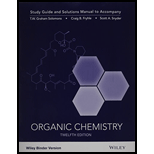
Concept explainers
Show how 1-pentanol could be transformed into each of the following compounds. (You may use any needed inorganic reagents and you need not show the synthesis of a particular compound more than once.)
(a) 1-Bromopentane
(b) 1-Pentene
(c) 2-Pentanol
(d) Pentane
(e) 2-Bromopentane
(f) 1-Hexanol
(g) 1-Heptanol
(h) Pentanal
(i) 2-Pentanone
(j) Pentanoic acid
(k) Dipentyl ether (two ways)
(l) 1-Pentyne
(m) 2-Bromo-1-pentene
(n) Pentyllithium
(o) 4-Methyl-4-nonanol
Want to see the full answer?
Check out a sample textbook solution
Chapter 12 Solutions
Organic Chemistry, 12e Binder Ready Version Study Guide / Student Solutions Manual
Additional Science Textbook Solutions
Chemistry: Structure and Properties (2nd Edition)
Chemistry: The Molecular Nature of Matter
Chemistry: A Molecular Approach (4th Edition)
Principles of Chemistry: A Molecular Approach (3rd Edition)
Organic Chemistry (8th Edition)
Essential Organic Chemistry (3rd Edition)
- Show how you would synthesize the following compounds, starting with acetylene and any compounds containing nomore than four carbon atoms.(a) hex-1-yne (b) hex-2-yne(c) cis-hex-2-enearrow_forwardShow how you would convert 2-methylcyclopentanol to the following products. Any of these products may be used as the reactant in any subsequent part of this problem. (a) 1,2-dimethylcyclopentanol (b) 1-bromo-2-methylcyclopentane (c) 2-methylcyclopentyl acetate (d) 1-bromo-1-methylcyclopentanearrow_forwardDevelop syntheses for the following compounds. As starting materials, you may use cyclopentanol, alcohols containing no more than four carbon atoms, and any common reagents and solvents. (a) trans-cyclopentane-1,2-diol (b) 1-chloro-1-ethylcyclopentanearrow_forward
- How could you convert butanoic acid into the following compounds? Write each step showing the reagents needed. (a) 1-Butanol (b) 1-Bromobutane (c) 1-Butenearrow_forwardElectrophilic aromatic substitution usually occurs at the 1-position of naphthalene, also called the a position. Predict the major products of the reactions of naphthalene with the following reagents.(a) isobutylene and HF (b) cyclohexanol and BF3 (c) fuming sulfuric acidarrow_forwardHow could you convert butanoic acid into the following compounds? Write each step showing the reagents needed. (a) 1-Butanol (b) 1-Bromobutane (c) Pentanoic acid (d) 1-Butene (e) Octanearrow_forward
- Predict the major products of dehydration catalyzed by sulfuric acid. (a) cyclopentylmethanol (b) 2-methylcyclopentanolarrow_forwardShow how to prepare pentanoic acid from each component. (a) 1-Pentanol (b) Pentanal (c) 1-Pentene (d) 1-Butanol (e) 1-Bromopropane (f) 1-Hexenearrow_forward(b) State the reagents needed to convert benzoic acid into the following compounds. (i) C6H§COCI (ii) C,H$CH2OH (iii) C6H$CONHCH3arrow_forward
- Use a Grignard reaction to prepare the following alcohols. (a) 2-Methyl-2-propanol (b) 1-Methylcyclohexanol (c) 3-Methyl-3-pentanol (d) 2-Phenyl-2-butanol (e) Benzyl alcohol (f) 4-Methyl-1-pentanolarrow_forwardPredict the products of the sulfuric acid-catalyzed dehydration of the following alcohols. When more than one product is expected, label the major and minor products. (a) pentan-2-ol (b) 1-isopropylcyclohexanol (c) 2-methylcyclohexanolarrow_forwardHow could you convert butanenitrile into the following compounds? Write each step showing the reagents needed. (a) 1-Butanol (b) Butylaminearrow_forward
 ChemistryChemistryISBN:9781305957404Author:Steven S. Zumdahl, Susan A. Zumdahl, Donald J. DeCostePublisher:Cengage Learning
ChemistryChemistryISBN:9781305957404Author:Steven S. Zumdahl, Susan A. Zumdahl, Donald J. DeCostePublisher:Cengage Learning ChemistryChemistryISBN:9781259911156Author:Raymond Chang Dr., Jason Overby ProfessorPublisher:McGraw-Hill Education
ChemistryChemistryISBN:9781259911156Author:Raymond Chang Dr., Jason Overby ProfessorPublisher:McGraw-Hill Education Principles of Instrumental AnalysisChemistryISBN:9781305577213Author:Douglas A. Skoog, F. James Holler, Stanley R. CrouchPublisher:Cengage Learning
Principles of Instrumental AnalysisChemistryISBN:9781305577213Author:Douglas A. Skoog, F. James Holler, Stanley R. CrouchPublisher:Cengage Learning Organic ChemistryChemistryISBN:9780078021558Author:Janice Gorzynski Smith Dr.Publisher:McGraw-Hill Education
Organic ChemistryChemistryISBN:9780078021558Author:Janice Gorzynski Smith Dr.Publisher:McGraw-Hill Education Chemistry: Principles and ReactionsChemistryISBN:9781305079373Author:William L. Masterton, Cecile N. HurleyPublisher:Cengage Learning
Chemistry: Principles and ReactionsChemistryISBN:9781305079373Author:William L. Masterton, Cecile N. HurleyPublisher:Cengage Learning Elementary Principles of Chemical Processes, Bind...ChemistryISBN:9781118431221Author:Richard M. Felder, Ronald W. Rousseau, Lisa G. BullardPublisher:WILEY
Elementary Principles of Chemical Processes, Bind...ChemistryISBN:9781118431221Author:Richard M. Felder, Ronald W. Rousseau, Lisa G. BullardPublisher:WILEY





